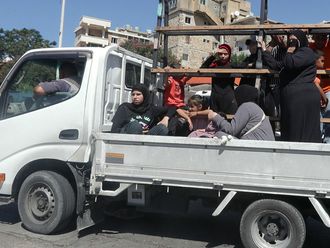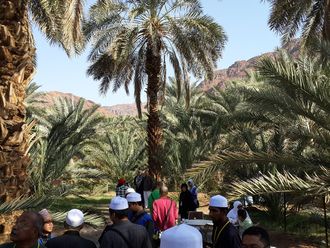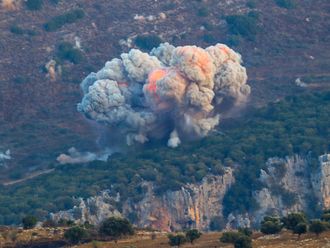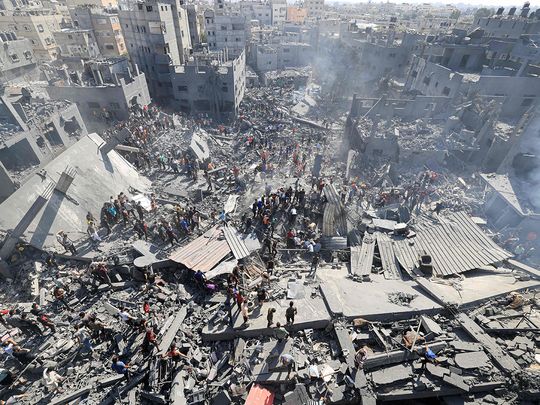
Gaza Strip: The sheer scale of destruction from the deadliest war in Gaza's history has made the road to recovery difficult to imagine, especially for people who had already lost their homes during previous conflicts.
After an Israeli strike levelled his family home in Gaza City in 2014, 37-year-old Mohammed Abu Sharia made good on his pledge to return to the same plot within less than a year.
The process was not perfect: the grant they received paid for only two floors instead of the original four.
But they happily called it home until it came under aerial assault again last October, following Hamas's attack on southern Israel.
This time, the family could not flee in time and five people were killed, four of them children.
The rest remain displaced nearly a year later, scattered across Gaza and in neighbouring Egypt.
"A person puts all his life's hard work into building a house, and suddenly it becomes a mirage," Abu Sharia told AFP.
"If the war stops, we will build again in the same place because we have nothing else."
No hope
With bombs still raining down on Gaza, many of the Palestinian territory's 2.4 million people will face the same challenge as Abu Sharia: how to summon the resources and energy necessary for another round of rebuilding.
"The pessimism is coming from bad experiences with reconstruction in the past, and the different scale of this current destruction," said Ghassan Khatib, a former planning minister.
That has not stopped people from trying to plan ahead.
Some focus on the immediate challenges of removing rubble and getting their children back in school after nearly a year of suspended classes.
Others dream of loftier projects: building a port, a Palestinian film industry, or even recruiting a globally competitive football team.
But with no ceasefire in sight, analysts say most long-term planning is premature.
"It's sort of like putting icing on a cake that's not yet fully baked," said Brian Katulis of the Middle East Institute in Washington.
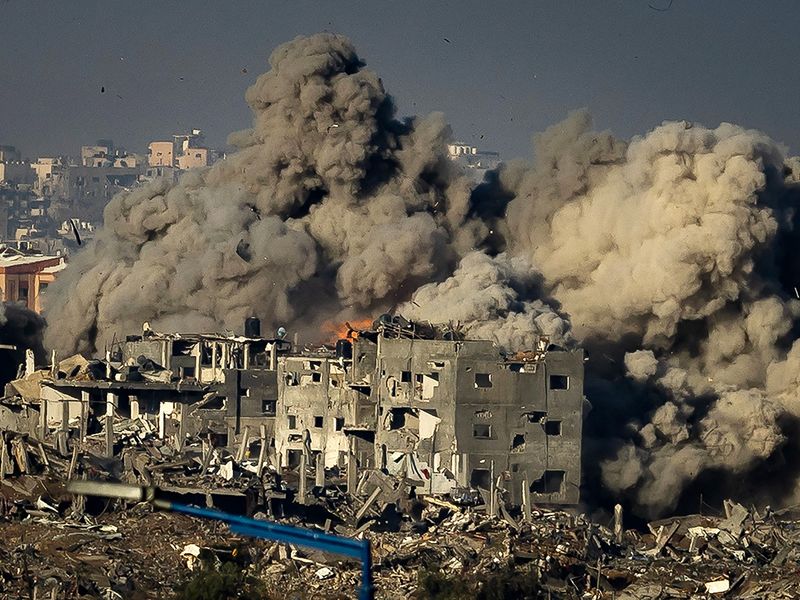
'People are fed up'
It could take 80 years to rebuild some 79,000 destroyed homes, the United Nations special rapporteur on the right to housing said in May.
A UN report in July said workers could need 15 years just to clear the rubble.
The slow responses to past Gaza wars in 2008-9, 2012, 2014 and 2021 give little reason for confidence that rebounding from this one will be any smoother, said Omar Shaban, founder of the Gaza-based think tank PalThink for Strategic Studies.
Regional governments have in the past pledged large sums but then failed to disburse them.
The Israeli blockade of Gaza, imposed after Hamas took control of the territory in 2007, remains firmly in place, sharply restricting access to building materials.
"People are fed up," Shaban said.
"They lost their faith even before the war."
Ambitious or unrealistic?
Despite the hopelessness, Shaban is among those putting forward more imaginative strategies for Gaza's postwar future.
Earlier this year he published an article suggesting initial reconstruction work could focus on 10 neighbourhoods - one inside and one outside refugee camps in each of Gaza's five governorates.
The idea would be to ensure the benefits of reconstruction are seen across the besieged territory, he told AFP.
"I want to create hope. People need to realise that their suffering is going to end" even if not right away, he said.
"Otherwise they will become radical."
Hope is also a major theme of Palestine Emerging, an initiative that has suggested building a port on an artificial island made of war debris, a technical university for reconstruction, and a Gaza-West Bank transportation corridor.
Other proposals have included launching a tourism campaign, building a Palestinian film industry, and recruiting a football squad modelled on the strategies of Qatar and Saudi Arabia.
"Maybe when you look on some of these, you would think they are, you know, dreams or something," Palestine Emerging executive director Shireen Shelleh said from her office in Ramallah in the Israeli-occupied West Bank.
"However, I believe if you don't dream then you cannot achieve anything. So even if some people might find it ambitious or whatever, in my opinion that's a good thing."
Khatib, the former planning minister, said it was not the time for such proposals.
"I think people should be more realistic," he said.
"The urgent aspects are medicine, food, shelter, schools."
But the sheer scale of bombardment and violence of the fighting have also disfigured the densely-populated Palestinian territory's urban landscape. AFP looks at the material impact of the war in Gaza.
- 169,000 buildings damaged or destroyed
Gaza is one of the most densely populated places on the planet. Before the war 2.4 million people had been living on a 365-square-kilometre (140-square-mile) strip of land.
By September 13, 2024, nearly 59 per cent of the Gaza Strip's buildings had been damaged or destroyed, according to satellite imagery analysed by US researchers Corey Scher and Jamon Van Den Hoek. That amounts to close to 169,000 buildings.
The worst damage was done in the first two or three months after Hamas's October 7 attack on Israel that sparked the war, the researchers said.
Hamas's unprecedented assault resulted in the death of 1,205 on the Israeli side, most of them civilians, according to an AFP tally of Israeli official figures.
The figure includes hostages killed in captivity in the Gaza Strip.
Since October 7, at least 41,455 Palestinians, most of them civilians, have been killed in Israel's military campaign in Gaza, according to data provided by the health ministry in the Hamas-run Strip.
Those figures are acknowledged as reliable by the UN.
- Rafah city half destroyed
Before the war, Gaza City in the north of the territory was home to some 600,000 people. Almost three-quarters of its buildings have been damaged or destroyed.
In Rafah, Gaza's southernmost city along the border with Egypt, the Israeli army launched a ground offensive in early May.
Although relatively spared compared to Gaza City, gutted facades and buildings stand testament to the scars of war.
Rights group Amnesty International said that 90 per cent of the buildings along 58 square kilometres of Gaza's border territory with Israel appear to have been "destroyed or severely damaged" between October 2023 and May 2024.
- Hospitals not functional
During the war, Gaza's hospitals have been repeatedly attacked by Israel, which accuses Hamas of using them for military purposes, a charge the militant group denies.
The territory's largest hospital, Al Shifa in Gaza City, was targeted in two offensives by the Israeli army, the first in November, the second in March.
The World Health Organization said the second operation reduced the hospital to an "empty shell" strewn with human remains.
By August only 16 of Gaza's 36 hospitals, or 44 per cent, were partially functioning, according to the WHO.
Data from the UN's Satellite Centre (UNOSAT) and geographic database OpenStreetMap also indicate that more than 60 per cent of Gaza's mosques have been damaged or destroyed.
- Nearly 85 per cent of schools damaged
The territory's largely UN-run schools, where many civilians have sought refuge from the fighting, have also paid a heavy price, with the Israeli army accusing Hamas of using them to hide its fighters.
As of July 6, UNICEF counted 477 schools damaged, representing nearly 85 per cent of its count of 564 facilities.
Of those, 133 have been seriously damaged and another 344 directly hit.
In September the UN's global fund for education in emergencies, Education Cannot Wait, said nearly 90 percent of Gaza's school buildings had been damaged or destroyed.
- 68 per cent of farmland
According to UN satellite imagery dating from August 27, 68 per cent of Gaza's farmland has been damaged, or 102 square kilometres. That includes 78 per cent of north Gaza's farmland and 57 percent of Rafah's.
In addition, 68 per cent of Gaza's road network has been damaged.
About 1,190 kilometres of roads have been destroyed, 415 kilometres badly damaged and 1,440 kilometres moderately damaged, according to a preliminary analysis by UNOSAT taking into account data up to August 18.
"It is unimaginable, the level of suffering in Gaza, the level of deaths and destruction have no parallel in everything I've witnessed since (becoming) secretary-general," UN chief Antonio Guterres said earlier this month.





